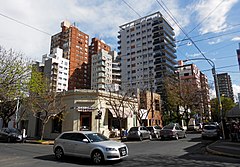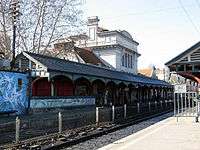Quilmes
Quilmes (Spanish pronunciation: [ˈkilmes]) is a city in the province of Buenos Aires, Argentina, on the coast of the Rio de la Plata on the south east of the Greater Buenos Aires. It is the seat of the eponymous county, and has a population of 230,810. It is located 17 km (11 mi) south of the capital of Argentina, the Autonomous City of Buenos Aires.
Quilmes | |
|---|---|
City | |
 | |
 Quilmes Location in Greater Buenos Aires | |
| Coordinates: 34°43′00″S 58°16′00″W | |
| Country | |
| Province | |
| Partido | Quilmes |
| Founded | 1666 |
| Declared city | 1916 |
| Government | |
| • Mayor | Mayra Mendoza (Frente de Todos) |
| Elevation | 17 m (56 ft) |
| Population (2001)[2] | |
| • Total | 230,810 |
| Time zone | UTC-3 (P) |
| CPA Base | B 1878, B 1879 |
| Area code(s) | +54 11 |
| Website | www.quilmes.gov.ar |
History
The Quilmes were a native tribe who lived in the surroundings of Tucumán. In the 17th century, after repeated attempts by the Spanish invaders to control their lands, the Quilmes were defeated and were forced to settle in a restricted colony (reducción) near Buenos Aires, where the authorities could control them. The settlement was thus established in 1666 as Exaltación de la Santa Cruz de los Kilme. The 1,000 km (621 mi) journey from Tucumán was made on foot, causing hundreds of Quilmes to die in the process. The colony had been abandoned by 1810 and had become a ghost town. The land was divided in parcels and the town of Quilmes was established in 1818. During the first British invasion, lasting 46 days in 1806, the British arrived from Montevideo through Quilmes and went to Buenos Aires from there.
Quilmes was also inhabited by British immigrants. Juan Clark, born in Yorkshire, England, was president of the municipality in 1855.[3] The Clark' were owners of land in Quilmes, and were linked to the Irish and Scottish community, established in the area since 1830s.[4]
In 1898 was established in the area the St. George's College, a private educational institution run by the Reverend Joseph Thomas Stevenson.[5]
The town's development accelerated during the wave of immigration in Argentina during the late 19th century, and Quilmes was considered as the location for a new provincial capital during the Federalization of Buenos Aires of 1880 (ultimately established in La Plata). The Argentine Air Force established a 220 ha (540 acre) base in East Quilmes in 1943. In 1944, Impa (Industria Metalurgica y Plastica Argentina) opened Argentina's first airplane plant at Quilmes. Impa had been blacklisted by the United States government due to its connections to Nazi-occupied Austria and fascist figures within Argentina itself. The airplanes were considered of "antiquated design" according to the New York Times.
Quilmes proper consists of two main parts, east and west, which are divided by the tracks of the Metropolitano passenger train line. East Quilmes has several relatively wealthy areas and a large shopping district. As one travels east toward the Río de la Plata, neighborhoods become increasingly poor, and two large villas miseria (slums) are found close to the river. These areas often experience severe flooding.
Quilmes is the home of two football teams: Quilmes Atlético Club and Club Atlético Argentino de Quilmes. The first was founded in the 19th century by Cannon J. T. Stevenson, and the second one was founded later, by Argentines who were not allowed to play for the QAC. They are two of the oldest Argentine football teams. The city has been chosen by FIH to host the 2014 Men's Hockey Champions Trophy.
The city also gives its name to the Cerveza Quilmes beer company, as this is where it was first brewed in 1888 where the brewery was started by Otto Bemberg; the establishment remains a leading employer in the city. Other significant manufacturers in Quilmes include textile maker La Bernalesa, glass maker Cattorini, construction materials maker Cerámica Quilmes, and climate control equipment maker Rheem.
Famous Quilmeños include television variety show host Susana Giménez, football forward Sergio Agüero, painter Carlos Morel, sculptor Victor de Pol, boxer Sergio Martínez, and the rock band Vox Dei. Aníbal Fernández, who was born in Quilmes, served as mayor from 1991 to 1995, and from 2003 as Minister of Interior, of Justice, as Chief of the Cabinet of Ministers, and Senator.
References
- "Falling Rain Genomics". Retrieved 2008-01-02.
- "INDEC Census 2001". Archived from the original on 2006-06-13.
- "Historia de Quilmes desde sus orígenes hasta 1941". José Alcides Craviotto.
- "Inmigración y agricultura en la época de Rosas". Editorial El Coloquio.
- "The History of St. George's College, Quilmes, Argentina". Joseph Thomas Stevenson.
External links
| Wikimedia Commons has media related to Quilmes. |
- - New York Times article from 1944 about new airplane factory at Quilmes
- Municipality of Quilmes - Official Quilmes website (in Spanish)
- UKULA Travel Section - Quilmes Travelogue
- Municipal information: Municipal Affairs Federal Institute (IFAM), Municipal Affairs Secretariat, Ministry of Interior, Argentina. (in Spanish) (in Spanish)

.jpg)